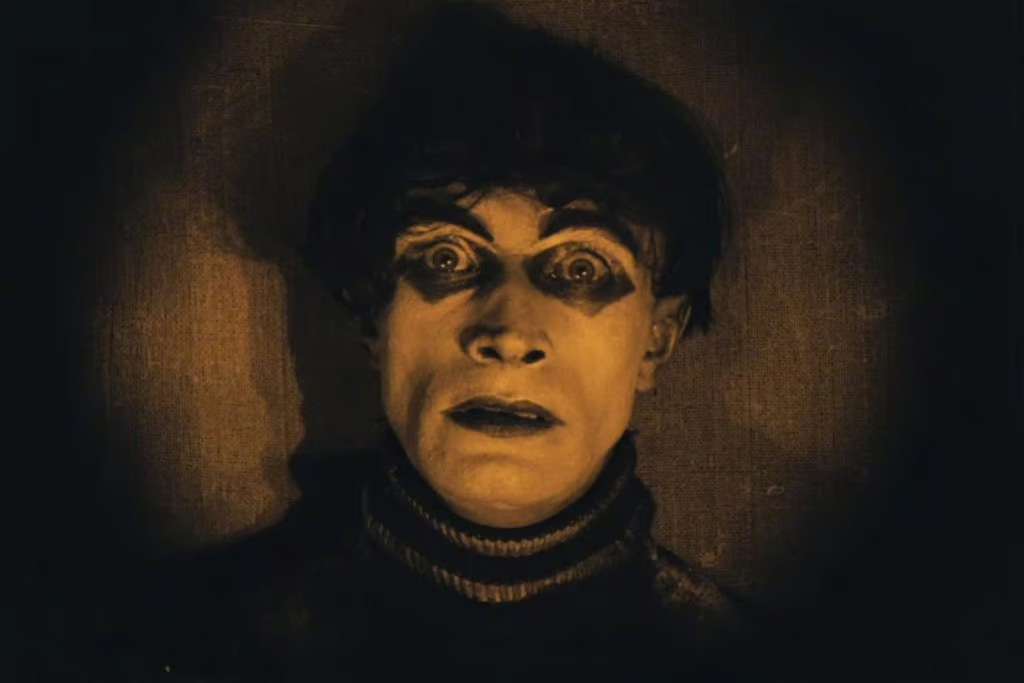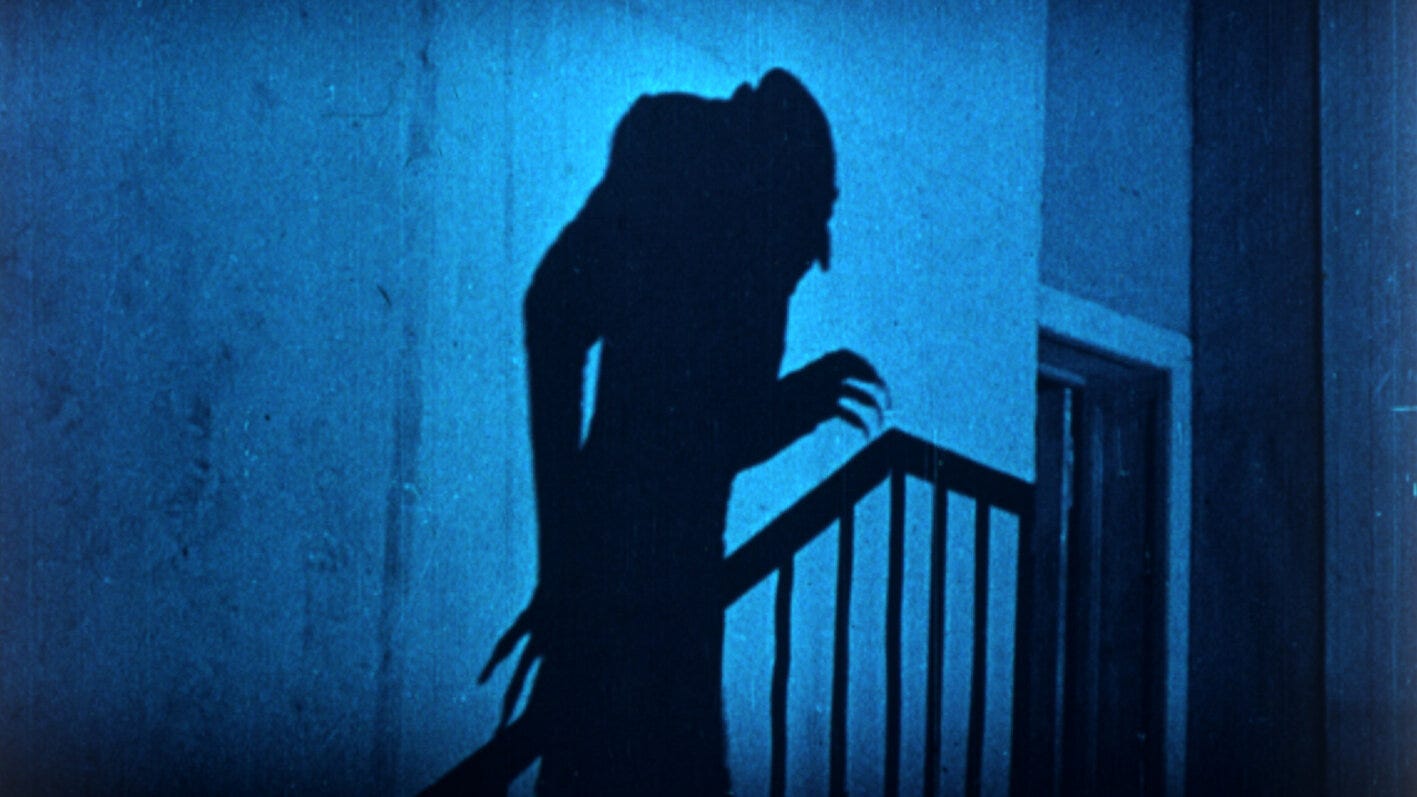A Brief Introduction to German Expressionism
What is this thing and why do people talk about it
Expressionism was an artistic movement across mediums during the 1920s. This was a sort of artistic rebellion to positivist and enlightenment philosophy at the time, which sought to rationalize the world. For many folks in an unstable Germany during the first part of the 20th century, rational explanations were unsatisfactory and the art of the time reflects that sense of dysphoria. Expressionists focused on the subjective, distorting reality to reflect an individual’s sense of the world.
Expressionism translated well to silent film. Silent film narratives rely on overt and non-naturalistic acting to compensate for the lack of dialogue to get the emotion of a scene across. I think the argument could be made that all early silent film is expressionistic, as the sets were all manufactured (the technology wasn’t available to make shooting on location or outside easy), and gestures, makeup, and costumes were all exaggerated to make up for a lack of dialogue.
Expressionist horror is defined by grim narratives and uncanny visuals. The plots and stories of the early Expressionist films dealt with insanity, betrayal and other "intellectual" topics which were in vogue at the time. Popular psychology at the time often focused on the subconscious, and artists explored disparate forms and content. The first Expressionist films, which lacked a generous budget, used set designs with wildly non-realistic, geometrically absurd angles.
The Golem
The Golem, a 1915 German sensation, is unfortunately lost to time. There are film fragments claiming to be from the original picture online, although this is difficult to verify. Because film is a delicate material, the chronology of early film is not a clear path and even things that were hugely popular are sometimes lost to history.
Because The Golem was a sensation, the filmmakers produced a 1917 sequel, and a 1920 prequel film, which can be found on The Internet Archive.
The Golem is effectively an early horror franchise.
The Golem draws its plot from Jewish folklore. Writer, Director, and actor Paul Wegener adapted the legend of the Golem, the clay creature given life to to rescue Jewish citizens in Prague from an emperor who accused them of the ritualistic murder of children (Kevin Hogopain, Penn Sate University). According to the Jewish Museum of Berlin, the first practical instructions on creating a golem can be found in medieval commentaries on Sefer Yetzirah (Book of Creation). Originally, creating a golem was a way for medieval Jewish mystics to come closer to God. It is debated whether Wegener's film paints a sympathetic portrait of the oppression Jews face, or if it perpetuates antisemitic stereotypes.
In the film, the Golem is captured through the lens of post World War Germany. According to Kevin Hagopain, Wegener's Golem character yearns for mortality and envies the delicate lives of the humans around him.
The narrative reflects trends in European storytelling and philosophy of the time, and the visual style of the film planted the seeds for German Expressionism.
The Cabinet of Dr. Caligari (1920)
In The Cabinet of Dr. Caligari, the title character, Dr. Caligari, has a human puppet, the somnambulist Cesare. Caught in a state neither sleep nor awake, Cesare must do his master’s bidding. A young man visiting the carnival, Francis, becomes suspicious when Cesare predicts his friend’s death, and then does everything in his power to uncover Caligari’s evil schemes.
The writers, Hans Janowitz and Carl Mayer, were staunchly anti-war after serving in World War I. Inspired by a trip to the carnival, the filmmakers had a vision for a fantastical story that would demonstrate the dangers of authoritarians.
Director Robert Wiene had started his career in theater, where Expressionism was waning in popularity. However, the film makers used the motifs of expressionism to create a sense of unease and fear without using the standard special effects technology of the time, effectively giving the art movement a second wind.
The film's aesthetic was borne as much from necessity as artistic vision. Germany was in the midst of an economic depression and materials, including electricity, were rationed. The sets were painted on cheap paper, with rays of light being painted onto the sets as they couldn’t actually light the sets.
The Cabinet of Dr. Caligari was an instant sensation in Germany. Critics praised it for demonstrating film's potential as high art, and it was popular enough among audiences to have an American release in 1921. It is regarded as the first psychological thriller, and the stylized sets, makeup, and acting style are still reflected in horror media today. Of all the films on this list, this one feels the most accessible to a 21st century audience. It has plot twists and a visual style that is timeless.
Nosferatu (1922)
The fact that Nosferatu exists today for viewing is a testament to its contemporary popularity. The story is an obvious plagiarism of Bram Stoker's Dracula. Bram Stoker's widow, Florence Balcombe, successfully proved the film plagiarized her intellectual property and requested all copies of the film be destroyed.
Obviously her wish was not granted. As soon as the late 1920s, a contraband copy was being screened for American audiences. Film scholars have since patched together found fragments and attempted to pair the original picture with its score. If you watch different releases of the film now, slight differences are apparent, most obviously in the score and title cards. Some copies use Bram Stoker's names for the characters, with others sticking with the less-copyright-infringing alternative names used in the 1920s.
Although the plot more obviously reflects the 1918 flu epidemic, as Orlok brings with him pestilence and death, the creators claimed that the film expressed their experiences serving in WWI.
As with The Golem, Nosferatu is often read as perpetuating antisemitism. The plot of Dracula projects xenophobia (the plot centers around a strange man from Eastern Europe moving to London to prey on the protagonist's fiance) and the styling of Max Schreck as Count Orlok is often read as perpetuating harmful stereotypes.
The Man Who Laughs (1928)
The Man Who Laughs is a synchronized sound film–meaning there is no matched dialogue but there are synchronized sound effects and music. It is also the only American film on this list, although it was made by a German director. It comes much later in the 1920s than other items on this list, and its creation reflects a trend in the 1920s into the 1930s of European filmmakers and artists escaping the rising tide of fascism and bringing their vision and experiences to foreign filmmaking markets.
German filmmaker Paul Leni was hired by Universal and brought to Hollywood. He completed four pictures for the studio before his untimely death in 1929.
In The Man Who Laughs, the main character, Gwynplaine, is disfigured as a child and works at a traveling carnival. He catches the metaphorical eye (because she is literally blind) of Dea, a sideshow performer. Which brings us to the wishy-washiness of the horror genre—really this movie is a romance, with the relationship between Gwynplaine and Dea and the “will they won’t they” being the center focus of the film. However, the movies’ first moments are of torture and violence. Categories are fluid.
The Man Who Laughs is expressionistic in that it is uninterested in the world of the real, and uses the fantastic to express very familiar and real experiences of everyday people. The characters in The Man Who Laughs, like Caligari and Nosferatu, are not realistic, but their dramatized form makes real the inner lives of these scared and dejected men. Like the other three films on this list, special effects are a key to the films visual aesthetic, especially with the character of Gwendylpaine, with this uncanny grin. The actor’s cheeks were held in the smiling pose with a sort of specialized retainer.
The appearance of Gwynplaine influenced The Joker’s character design. So, even though this is a lesser known movie, its influence is still felt in American pop culture.
Thank you so much for reading! This was a fun first dip into the world of the silent era.
Sources:
Brill, O., & Rhodes, G. D. (2016). Expressionism in the Cinema. Edinburgh University Press.
Stojanova, C. (2019). German Cinematic Expressionism in Light of Jungian and Post-Jungian Approaches. Acta Universitatis Sapientiae. Film and Media Studies, 16, 35–58.
Hutchinson, P. (2019). The Man Who Laughs. Sight & Sound, 29(8), 86.
Keith-Smith, B. (2000). Expressionism. In M. Konzett (Ed.), Encyclopedia of German Literature (1st ed.). Routledge. https://search.credoreference.com/articles/Qm9va0FydGljbGU6MjkwNDY1?aid=106288
The man who laughs. (1928). In Films On Demand. Films Media Group. https://fod.infobase.com/PortalPlaylists.aspx?wID=106288&xtid=57084




